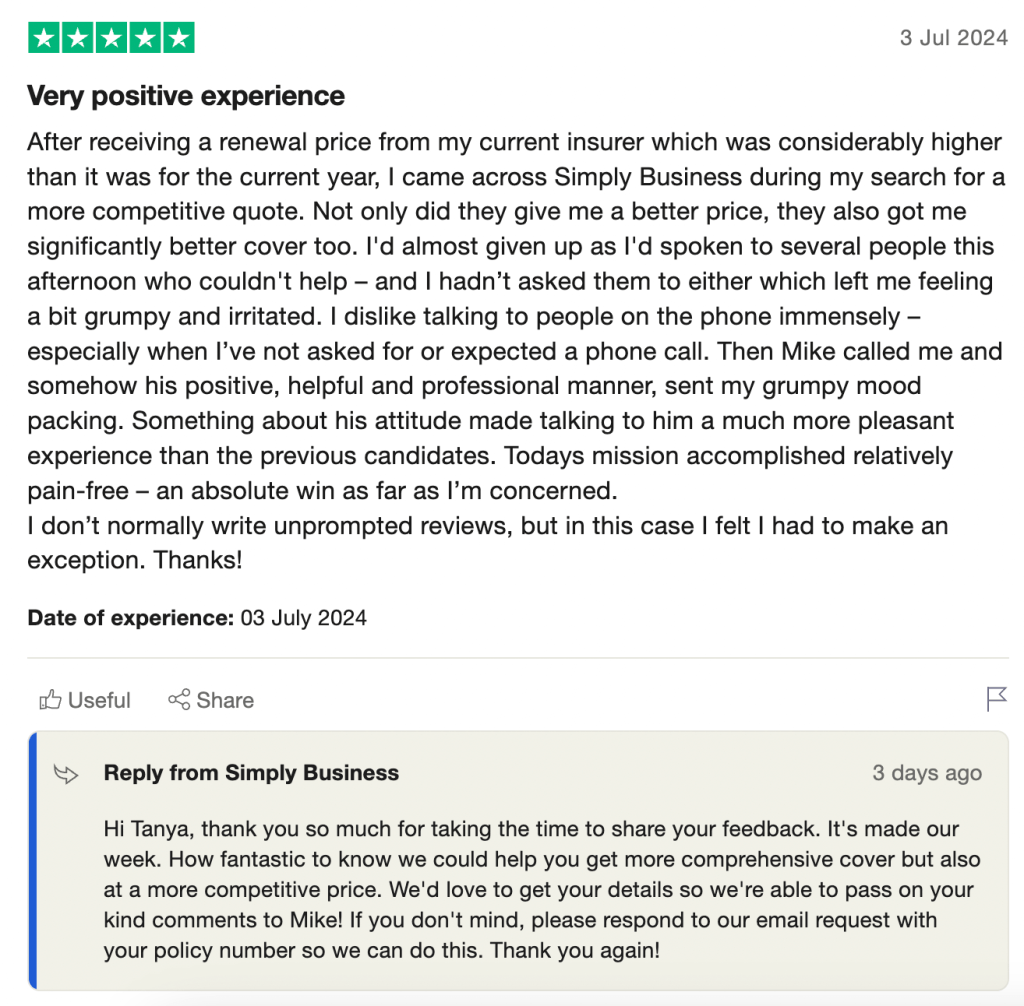Wondering how to grow your business without spending more on marketing?
Listing your business on Trustpilot gives your customers a chance to review their experience, so others can check before committing to your product or service. It also gives you an insight into what’s working well, and what isn’t.
Here, we’ll explore how to get started with your Trustpilot business profile, plus tips for responding to reviews, and how to encourage more customers to share their feedback.
Read on for nine steps to getting good quality Trustpilot reviews.
- Create a Trustpilot account
- Choose a category for your business
- Customise your profile
- Check against competitors
- Invite customers to write reviews
- Reply to reviews
- Add Trustpilot to your website
- Use automated invitations
- Include Trustpilot in your marketing
How does Trustpilot work?
Trustpilot is a free online community for consumers to review their buying experience with local businesses.
Businesses are given a ‘TrustScore’, which is then shown as a star rating from one to five. The score is based on overall satisfaction of reviewers and takes timespan and frequency into consideration.
If you have fewer than 10,000 reviews, your TrustScore is recalculated immediately after a new review is posted. For businesses with more than 10,000 reviews, the score is updated daily.
Your profile can also display how you rank in your category if you’re actively asking for reviews and have received 25 or more in the last 12 months.
Are Trustpilot reviews reliable?
Trustpilot is designed for people to review a ‘genuine buying experience’, and there are various features to help the community feel confident these are real.
Verified Trustpilot UK reviews
For example, some reviews are marked ‘verified’ when:
- you send an invitation to customers to review you via Trustpilot
- reviewers provide documentation to show their experience
Verified business profiles (and reviewers)
A business can also be given a ‘verified’ badge on their profile to help show people they are a genuine company. To do this you’ll need to share at least one of these forms of identification with Trustpilot:
- proof of identity (e.g. passport, driving licence)
- contact details – you can sync this with your Google Business Profile
- registered domain name ownership
- bank account registration
It’s possible for consumers to filter their search for businesses so they only see ‘verified’ or ‘claimed’ companies, so it’s well worth putting the time in.
Fraud detection and option to flag reviews
If you think someone’s written a review without having used your product or service, read our guide to how to respond to fake online reviews. With Trustpilot you can flag a review if you don’t think it’s based on a genuine experience. The reviewer can be asked for evidence to show they did buy your product or service, and it’ll then be marked as ‘verified’ if this is genuine.
How to get Trustpilot reviews: a 9-step guide
Here we’ll look at how to get reviews on Trustpilot in detail, from creating an account to including the platform in your day-to-day customer comms.
Step 1: Create your Trustpilot business account
The first step is to sign up for a Trustpilot account with your email address. You can also fill in information about your company and business website.
You’ll have the option to sign up to a free plan or opt to pay £259 a month for additional benefits. Just choose the price and plan that works for your business.
Step 2: Choose a category for your business
From pet stores and hair care to restaurants and construction, there’s a category for any business to help people find products and services on Trustpilot.
Make sure you tag your profile with all the relevant categories to help your business show up in the search results. For example, if you’re a plumbing and heating business you could list yourself in the ‘air conditioning contractor’, ‘gas engineer’, ‘gas installation’, ‘central heating’, and ‘plumber’ categories.
Step 3: Customise your profile
Describe your business using at least 200 words so customers know what you offer and your credentials. This also helps your business appear in Google search results, so take care using keywords that potential customers might be searching for.
Make sure you let people know how to get in touch with you too.
Step 4: See what your competitors are doing
Reading reviews of some of your main competitors can help you understand some of their strengths and weaknesses, and perhaps indicate opportunities for your business too.
If you notice people are writing negative reviews about a competitor’s delivery times, for example, you could look at how your business is doing and whether you can offer a better service.
Read our guide to competitor analysis for more tips.
Step 5: Invite your customers to write reviews
It sounds simple but one of the best ways to get more reviews is to ask for them.
With the free Trustpilot for Business plan you can send up to 50 invitations a month, while paid-for plans give you the opportunity to send even more review invites.
Trustpilot says businesses that regularly invite customers to write reviews tend to have a higher TrustScore, so it’s worth taking an active approach to this.
Step 6: Reply to reviews
Positive or negative, it’s good practice to reply to reviews people have written about your business on Trustpilot. This shows the human behind the business and that you really value their feedback.
Your reply will show underneath the review and be visible to people browsing your profile, so it’s important to take a calm and empathetic approach if someone has had a bad experience. And of course, don’t forget to thank people who’ve written a glowing review too.
Check out our guides on how to respond to online reviews and how to deal with complaints from customers for more guidance.

Replying to reviews is good practice. Trustpilot 2022.
Step 7: Add Trustpilot to your website
You can add a ‘Trustbox’ to your website that shows your review count and encourages people to write a review. This will take them off your site and over to your Trustpilot business profile so they can write their review.
Step 8: Use automated invitations
It’s possible to invite your customers to review your business automatically using Trustpilot’s automatic feedback service.
You just need to BCC Trustpilot into a transactional email to a customer and it’ll trigger an invitation for them to review their experience. You can personalise the invitation too so it captures your brand and tone of voice.
Step 9: Include on your marketing and delivery notes
Remind people that they can find you on Trustpilot by including the logo on your marketing materials. You could also include a card in any product packaging to prompt happy customers to review your business when they receive their delivery.
For more in-depth support and guides, visit Trustpilot’s Help Centre.
Do you have any more tips for building online reviews? Let us know in the comments section below.
Other small business guides:
- how to get Google reviews for your business
- what is good customer service
- how small businesses can tackle fake online reviews
- customer retention strategies for small businesses
Looking for self-employed insurance?
With Simply Business you can build a single self employed insurance policy combining the covers that are relevant to you. Whether it’s public liability insurance, professional indemnity or whatever else you need, we’ll run you a quick quote online, and let you decide if we’re a good fit.
Photograph: pikselstock/stock.adobe.com
Photograph: pikselstock/stock.adobe.com
